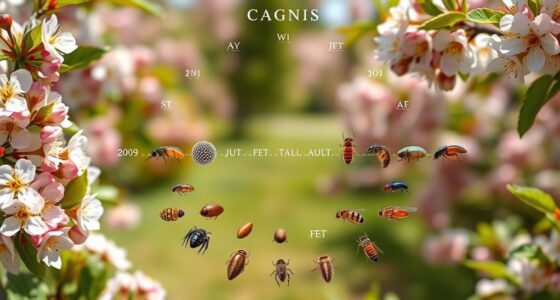To set up a weekly garden monitoring routine, pick a specific day each week to walk through your garden systematically. Check all sections for early signs of pests, disease, or plant stress, paying close attention to vulnerable plants. Use notes or photos to track changes and patterns over time. Staying consistent helps catch problems early and maintain a healthy garden. Keep going, and you’ll discover practical tips to make your routine even more effective.
Key Takeaways
- Designate a specific day each week for a consistent garden walk-through to establish a routine.
- Systematically inspect all garden sections, focusing on vulnerable or high-risk plants.
- Use notes or photos to document observations and identify emerging issues early.
- Look for signs of pests, diseases, or plant stress such as discolored leaves, chewed foliage, or wilting.
- Adjust care practices based on findings, incorporating organic and preventive measures to maintain plant health.

Have you ever wondered what it takes to become a successful scout? It’s not just about wandering through your garden; it’s about paying close attention to every detail that might signal trouble or health. Setting up a weekly monitoring routine is essential, and it starts with mastering pest identification and understanding plant health. When you know what pests look like and how they affect your plants, you can catch problems early, before they become widespread or severe. Recognizing the signs of pest activity—such as chewed leaves, sticky residue, or tiny insects—is key. But it’s equally important to observe your plants’ overall health. Look for yellowing leaves, wilting, spots, or abnormal growth. These clues can tell you if your plants are under stress or if pests are already taking a toll.
Successful scouting requires keen observation of pests and plant health indicators.
To establish an effective routine, designate a specific day each week to walk through your garden. Use this time to systematically check each section, paying attention to the most vulnerable plants or those showing early symptoms of distress. As you inspect, take notes or photos. This habit helps you track changes over time and catch patterns that might indicate recurring issues. When identifying pests, get familiar with common ones that target your specific plants. Some pests may be tiny, almost invisible to the naked eye, so carrying a magnifying glass can be helpful. The key is to distinguish between harmless insects and those that pose a threat. Beneficial insects like ladybugs or predatory mites are allies, while aphids, whiteflies, and beetles often cause damage if left unchecked. Engaging with natural materials and understanding their role in sustainable practices can further support your garden’s health.
Monitoring plant health goes beyond pest detection. Keep an eye on watering practices, soil conditions, and nutrient levels, as these influence how resilient your plants are against pests and diseases. If you notice a decline in plant health, investigate further to determine whether pests, disease, or environmental stressors are responsible. Consistent weekly checks create a proactive approach, allowing you to intervene early with integrated pest management strategies, organic controls, or adjustments in care routines.
Ultimately, becoming skilled at pest identification and understanding plant health will make you a more effective gardener and scout. Your routine builds a deeper connection with your garden and enhances your ability to maintain healthy, thriving plants. It’s about developing a keen eye, staying observant, and acting promptly. With practice, your weekly monitoring will become second nature, and you’ll be able to catch issues before they escalate. Remember, the goal isn’t just to react to problems but to prevent them, making your garden a resilient, vibrant space that rewards your dedication and attention.
Frequently Asked Questions
What Tools Are Essential for Weekly Garden Scouting?
For weekly garden scouting, you need essential tools like a hand lens for close inspection, a notebook to log observations, and pruning shears for quick removal of pests or damaged plants. Keep your garden tools well-maintained to prevent disease spread. Stay aligned with your seasonal planting schedules, and regularly check for pests or diseases. These tools help you stay proactive and guarantee your garden thrives year-round.
How Do I Identify Common Pests Quickly?
Think of pest identification like playing detective—sharp eyes and quick reactions are key. To identify common pests rapidly, examine plants thoroughly, focusing on leaves, stems, and undersides. Look for telltale signs like chewed leaves, sticky residue, or strange shapes. Use a magnifying glass if needed. Familiarize yourself with images of pests and damage. This way, you can detect problems early and take swift action to protect your garden.
When Is the Best Time of Day to Scout?
You should scout your garden early in the morning or in the evening when pests are most active. The best time of day is typically in the morning because pests tend to be more visible before the heat of midday, or in the evening when they become active again. Avoid midday hours, as high temperatures can make pest detection difficult and plants less accessible. Keep consistent for effective monitoring.
How Can I Record and Track Pest and Plant Health?
Did you know that tracking pest lifecycle stages can improve control by 50%? To record and track pest and plant health, use a garden journal or digital app. Note pest sightings, plant symptom identification, and lifecycle stages. Take photos and record dates for comparison over time. This helps you spot trends, anticipate problems, and make informed decisions to protect your garden effectively.
What Should I Do if I Find a Pest Outbreak?
If you find a pest outbreak, act quickly to prevent it from spreading. Start by removing the affected plants or pests manually. Use natural remedies like neem oil or insecticidal soap to target pests safely. Focus on pest prevention by encouraging beneficial insects and maintaining plant health. Regular monitoring helps catch issues early, ensuring your garden stays healthy and pest-free. Stay consistent with your routine for the best results.
Conclusion
So, there you have it—your secret weapon against pests and chaos. With just a little effort each week, you’ll keep your garden thriving and pests at bay, proving you’re not just a plant parent, but a garden ninja. Who knew that a simple routine could save you from the heartbreak of lost crops or a pest invasion? Now, go forth and scout like a pro—your plants will thank you, and maybe even send you a thank-you card.









